Students launch new ‘desi-gned’ magazine
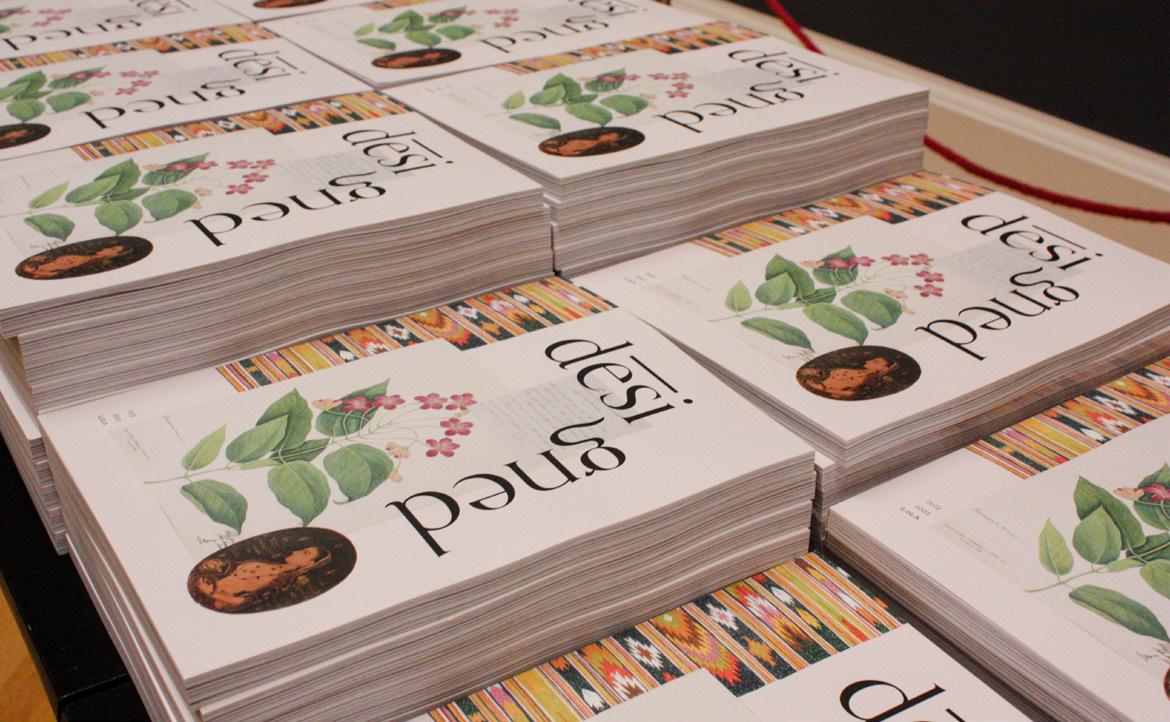
Design, art magazine celebrates South Asian culture, aims to topple barriers to knowledge
BY KATHY WANG & JULIA VAZ UNIVERSITY NEWS EDITOR & METRO EDITORWhen Siddharth Thuppil, a student at the Rhode Island School of Design, introduced Yukti Agarwal ’24.5 to his “birth child,” Agarwal jumped at the opportunity immediately. Together, they created “desi-gned,” New England’s first publication for the South Asian diaspora.
On Thursday, the publication celebrated its inaugural issue at the Rhode Island School of Design Museum’s Grand Gallery.
Agarwal, who currently serves as desi-gned’s editor-in-chief — Thuppil, now graduated, is listed as the founding editor — said the magazine, which combines design, personal reflections and academic research, centers native terminology and seeks to solidify histories created by South Asians.
“There aren’t a lot of knowledge archives of South Asian history,” Agarwal said.

The word “desi,” according to the magazine, is the “ethnonym of the people, cultures

and products” of South Asia. The title of the publication, desi-igned, highlights South Asian representation while emphasizing the arts and design aspect of the magazine, according to Agarwal.
Through desi-gned, Agarwal hopes to present South Asian experiences, which are diverse but united by the “relics of human triumph and human suffering,” without “fetishizing our own culture.”
“We were thinking about … what does it mean for us — the South Asians — to live in New England and to study (at) Brown and RISD, which are two (institutions) that
Report finds low teacher retention, diversity at PPSD
pandemic and which are due to the 2019 state takeover of the district.
BY STELLA CHEN SENIOR STAFF WRITERAccording to a March 15 report from Brown’s Annenberg Institute for School Reform, the Providence Public School District continues to face growing teacher attrition — a challenge since the onset of the COVID-19 pandemic. The report, part of the Annenberg Institute’s ongoing partnership with PPSD and the Rhode Island Department of Education, also detailed the district’s struggles to attract new applicants and increase diversity among educators.
“It’s way more nuanced than I think we were expecting” when research began last fall, said Kate Donohue, senior project manager at the Annenberg Institute and an author of the report. Donohue added that it is difficult to distinguish which challenges covered by the report can be attributed to the
“In our brief, we report on the three-year (teacher) retention rates,” Donohue said. “It’s lower than the rest of the state, but when you look at other urban districts, there’s more and more data coming out … which are on par (with) or higher than PPSD.”
But “that doesn’t mean it’s an issue that they shouldn’t care about,” she added.
“Nothing in the Annenberg report was remarkable,” wrote Maribeth Calabro, president of the Providence Teachers Union, in an email to The Herald. “I think we would be remiss if we failed to discuss the impact (that) the teachers leaving (and) vacancies are having on teaching and learning.”
According to Donohue, around 150 teachers left the district last year.
“If we use an example of 150 classroom teachers leaving, and each teacher has 22 students,” Calabro wrote, “that means at some point, 3,300 students may be
were built on colonial exploits and on native lands,” she said. The project explores ways to “contextualize our existence here today in relation with these histories.”
‘Labor of love’: Research, writing, funding desi-gned is divided into four major sections: “material memories,” “spaces and places,” “transcontinental conversations” and “literary musings.”
“Material memories” focuses on the relationships between objects and their
UNIVERSITY NEWS
Dean of admission discusses impact of siblings on admissions, applications from twins
BY OWEN DAHLKAMP SENIOR STAFF WRITERWhen identical twins Kayla Mukai ’25 and Kelly Mukai ’25 applied to colleges, their processes were identical as well. They applied to the same list of schools — and were accepted, waitlisted and rejected by the same schools.
“It was exactly the same,” Kelly Mukai added.

When applying to Brown, students must indicate whether they have a sibling applying during the same admissions cycle. Students can also indicate that they have a sibling already enrolled at an institution of higher education — at Brown or elsewhere.

“Every applicant is reviewed individually, holistically and contextually,” Logan Powell, associate provost for enrollment and dean of admission, said in an interview with The Herald.

“We very often make separate decisions on twins in the applicant pool,” he added, explaining that the same is true for any number of siblings applying.
Proposed project combines I-195 parcels, Brown property
METRO Proposal includes initial residential building, future mixeduse developments
BY RHEA RASQUINHA METRO EDITORA newly proposed mixed-use project in the I-195 Redevelopment District would combine two parcels with an adjacent property owned by the University, according to an April 12 University press release. The project — proposed by Boston developer CV Properties — includes an initial residential building and longterm plans for two other mixed-use developments on 195 Parcels 14 and 15 as well as the adjacent University property at 198-200 Dyer Street, according to the release.
According to a letter of support from the University to the I-195 Commission, the University has endorsed the project, offering its property for the project contingent on the selec-
tion of CV Properties’ proposal“Brown already has significant investments, academic, research and administrative activity in this area of Providence,” the letter from Executive Vice President for Planning and Policy Russell Carey ’91 MA’06 reads. “Therefore, Brown is extremely interested in the outcome of the RFP and is aligned with the Commission in its commitment to furthering the positive development of this neighborhood.”
According to the release, the proposed residential property — which would stand on Parcel 14 and the University property — would create 375 construction jobs and 30 permanent jobs. The master proposal could create at least 1,500 construction jobs and 1,600 high-skill permanent jobs. The project would also provide new space for commercial and laboratory use.
CV Properties’ proposal states that the project team would include architecture firm SGA, engineering and design group VHB and Shawmut
Siblings at U. talk admissions experiences
Powell added that there “is no legacy consideration for sibling applicants,” but noted that knowing when an applicant’s sibling already attends Brown is “helpful — it’s interesting and we always take note of it.”
“We try to balance the individual review that we do for every student with the impact on the family,” Powell said, acknowledging that potential family dynamics could arise due to differing decisions. “We pay very close attention to when those decisions are different … and we verify that those are the right outcomes.”
But despite their identical list of schools they were interested in, the Mukai twins were not set on going to
school together. “It definitely wasn’t set that we were gonna go to the same college,” Kelly Mukai said. “We were very open to going to different schools.”
Rebecca Ward-Diorio ’23 and Lily Ward-Diorio ’23 took an entirely different approach: Brown was the only school they applied to together.
“We actually did not intend to go to the same school,” Rebecca Ward-Diorio said. “That was never the plan.”
“We were really, really competitive in high school, so (applying to the same schools) was our biggest fear and probably why we didn’t apply to more together,” Lily Ward-Diorio added.
METRO
High turnover among teachers part of national trend, state officials sayASHLEY CHOI / HERALD KAIOLENA TACAZON / HERALD
secrets an interrogation
by Emily TomHere the stars are bright and begging, like pennies at the bottom of a well. Here the trees are green, even in the heart of winter, for here the winter does not exist. Here I feel hidden, tucked away into a pocket of the night. We are so far from the city, from the lights, from the highway. It is the first time I have been somewhere so empty.
Outside, the roots rustle. Wild chickens scratch at dead leaves. They have been doing this all night. The first time they did, the sound startled us so much that we reached for each other. But now we are used to it, the same way we are used to sharing a bed, laying sideby-side like two halves of an equals sign. We lie there like little kids, giggling.
Tell me a secret, I say.
The room is too dark to see each other’s faces, but I can see M’s silhouette. You already know everything, he says, but both of us know that’s not true.
the bittersweet taste of nostalgia
 by Samira Lakhiani
illustrated by Joyce Gao IG: @orangefrog_art
by Samira Lakhiani
illustrated by Joyce Gao IG: @orangefrog_art
As if by reflex, I grab the keys off the kitchen counter and toss them to my sister. A frequent inhabitant of the passenger seat, I am more than happy to relinquish control of the car. We head into the sticky garage, and the familiar humidity of a Rhode Island summer greets us. Our routine begins.
My sister turns on the car, opens the sunroof, and lowers the windows. I plug in my phone and promptly get to work on Spotify. We have about a 15 minute drive ahead of us, so I carefully curate a four song queue, and add one more for good measure.
"Bet On It" comes on and we both instantly smile at the beat. Although we are driving at under 30 miles an hour in our small suburban neighborhood, our energy is high as we start belting out the words to the soundtrack of arguably the best summer movie of all time, High School Musical 2. We don’t miss a single lyric, smiling through the entire three and a half minutes. At some point during the bridge, I am overcome with joy. The sonic blast from the past, along with the sun shining through the car and our impending trip to our favorite ice cream shop, is overwhelmingly blissful.
The same thing happens with the next song, and the next, and the next, starting with “He Could Be the One,” from our favorite childhood show, Hannah Montana. For 15 minutes, we aren’t stressed out about going back to college next week. We’re back in elementary school, carefree and protected. I am amazed by how powerful nostalgia can be; despite being home, I am inundated with a feeling resembling homesickness.
I’ve always been sentimental; browsing through old photographs and perusing my very crowded memory box are foolproof ways to cheer me up when needed. But I can’t help but wonder why I seek solace by reminiscing about a birthday party, a family vacation, or a school field trip—moments in my life that are long gone. In theory, I could seek the same comfort by thinking about the wonderful things about my life in the present, but the feelings that ensue from nostalgia cannot be replicated. They are tender and uplifting, and yet they evoke an unavoidable twinge of heartache...
The immense strength...

Warshay, “The Routine of Nostalgia”
“As the snow turned everything still, silencing the rush of oncoming traffic, emphasizing the sound of my breathing, a familiar ache twisted in my stomach: homesickness, loneliness, maybe a tinge of nostalgic grief.”
—Danielle Emerson , “Coffee
Grounds” 3.26.21I have never had a brother, but this is what I think it must be like on the best of days: the two of us, cocooned. The knowledge that, no matter what he says, I would still do just about anything for him.
M tells me his secret. His breath is warm against my ear. When he speaks, I feel him tilt his chin down, as if in prayer...
an italian revelation in six courses
on loving pasta and people
by Jeanine Kimcw : mentions of food-related anxiety, and body dysmorphia
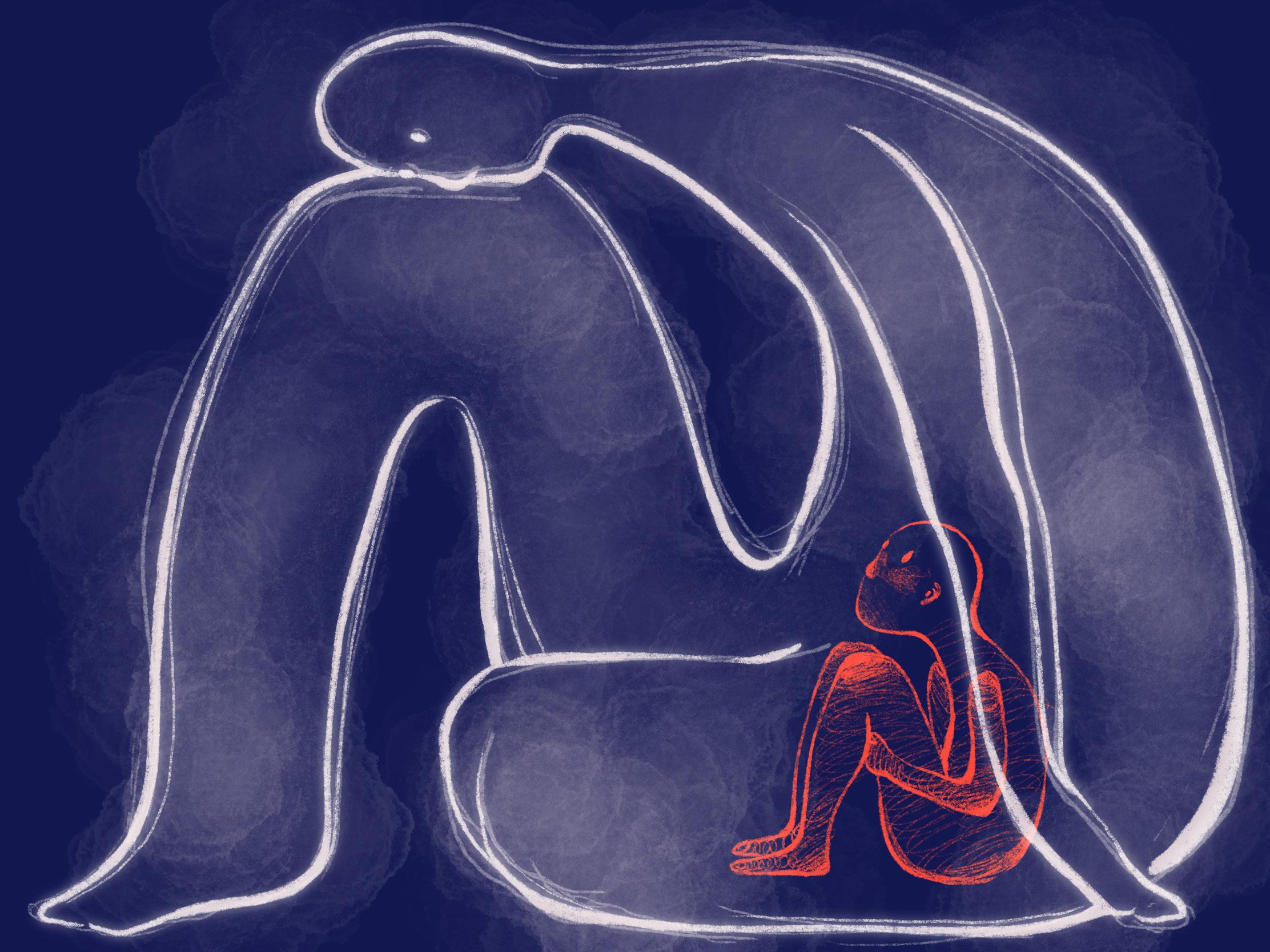
Small cobblestone streets, clotheslines overflowing with bright linens and colorful underwear, tiny dogs yapping as they lick the crumbs of pastries and cornettos off the road—Italy is a picturesque destination, one colored by decades of romanticisation in the media. Despite its aspirational depiction as a nation living in rustic nostalgia where every street is imbued with thousands of years of history, the most popular thing about Italy is its food. Often called the best cuisine in the world, Italian food draws people in with its rich sauces, fresh flavors, and accessible appeal. However, despite the world's totalizing adoration, Italian cuisine is also a minefield of terror and paralyzing anxiety for those who struggle with eating and body image; every slurp of buttery pasta and every bite of cheesy pizza can spark panic beyond comprehension.
When I went to Italy this spring break as a romantic getaway with my boyfriend of over two years, it started off as a nightmare of deliciousness and temptation, one that triggered crushing guilt with every orgasmic bite of savory goodness. Yet, as the week progressed and I ate more (and more and more), the feelings dissipated. Rather than spiraling anxiety, I found myself in a perfect state of romance and bliss, one unencumbered by the ominous footsteps of worrying...
looking back to move forward
“The passing of time is easy to miss when you don’t pay attention. It sweeps by, and sometimes we want it to.”
—Marin
my dad presents: zhuge liang the
man, the myth, the legend?
by AJ Wu“Liu Bei’s men were getting closer. You could hear them beating their drums, waving their torches, shouting their war songs into the frigid air as they sailed closer and closer.
Cao Cao’s enemy camps were caught unawares on the riverbank and frantically assembled to face what appeared to be a massive army.
Only Zhuge Liang, Liu Bei’s best and most trusted strategist—and the organizer of the whole affair— knew the truth. He knew that the cacophony of drums and yells were produced by fewer than 30 men. He knew that under the thick cover of fog, Cao Cao’s armies on the riverbank would not be able to tell the size of the approaching enemy fleet. The straw-stuffed dolls that filled each boat would appear as formidable enemy soldiers, standing six feet high and carrying giant staffs.
Zhuge Liang peered out at the banks, squinting to see Cao Cao’s next move. A war horn sounded twice. A volley of arrows darkened the sky, arcing through the falling snow, finding their marks buried deep in the army of straw men that Zhuge Liang had filled his fleet with.
Zhuge Liang ducked to safety, satisfied. His men hunkered down below deck and waited out the attack. By the time the fleet had sailed miles beyond the
enemy camp, they were 100,000 arrows richer without having expended any of their own resources and Cao Cao was none the wiser.”
My dad paused to catch his breath. I leaned back against an old oak and waited.
“Tell me more about Zhuge Liang.”
“Well, he was the most cunning man in the Three Kingdoms. He was brave and loyal. He was decisive and always weighed every move he made against the consequences that could follow.”
I practiced my swordplay with my hiking stick—a spindly branch picked up half a mile ago—against the tree, denting the stick with every carefully placed strike.
“He was all these things. And he was still only a man.”
Whenever my dad and I went hiking, we would pass the time by telling stories. Or, more accurately, I would pester him to tell me stories about my two favorite subjects: his own childhood, and the legendary Chinese hero, Zhuge Liang.
While we are quite sure Zhuge Liang is a real man who lived and died during the Three Kingdoms period, what we know of him today has long since left the constraints of his actual life and slipped into legend. His most well-known exploits...
Ways to Beat the Heat
LIFESTYLE
crossroads
post- mini crossword 9
by Walter Zhangroaming holiday the journey, not the destination
by Malena ColonAs we shuffled through the halls of the Vatican Museums, we were packed like sardines, herded like cattle, moving like a flock of sheep. Not much thinking was required of us, except maybe to keep on walking— do not stop in the immediate path of another person and hinder the current of this sea of people. It was crowded, and it was not even peak tourist season. Any solo wanderer attempting to meander through these dozens of rooms would swiftly be swept up by the mass of tourists pouring through the galleries. Each tourist seemed to be in one gigantic rush toward an end goal: the Sistine Chapel.
Reflecting on this experience, I am instantly reminded of the final passage from a short story, “Dark Neighborhood” by Vanessa Onwuemezi. It’s about a line of people waiting for the gates to open, a story where there is nothing for the characters to do except wait for their unknown and unpromised salvation. When the gates finally open, the narrator can’t help but wonder about the point of it all:
“Compelled I keep marching forwards on my toes in this endless advance that goes nowhere, and I ask myself why we can’t turn around, why we never turned around to look for some other way through. Why us starved people have been waiting, wanting hopeless wants...
1. Cuddle with a 900 year old vampire
2. Drink propylene glycol
3. Listen to Arctic Monkeys
4. Do icebreakers (or don’t)

5. Skate on thin ice
6. Take your clothes off ;)
7. Fight fire with fire (beat the heat)
8. Shiver me timbers
9. Seek affection from your situationship
10. Shade
spring weekend april showers bring may flowers
by Section edsfull camera roll by
Rachel MetzgerI was raised by springs that fell through the crack between winter and summer, a season symbolized only by the events that rendered its yearly timing: Passover Seders with my family over spring break, preparation for finals, a class trip I had been eagerly anticipating... memory coupons by Elijah
 Puente
Puente
Thankfully, these priceless coupons never expire. I never considered myself very aggressive, but growing up, one Sunday every year, my primal instincts kicked in. My cousins and I... april come she will
by Klara Davidson-SchmichIn Florida, there are no seasons. It's hotter in July than it is in January, but only barely, and the humidity is as familiar as the mosquitoes. Maybe that’s why seasons in Providence feel like such a revelation... [untitled]
by Daniella CoyleThat weekend, the snow melted across New England into an irregular coat of crystalline water. Drops of it, falling off rooftop gutters, congregated into rivulets on the way down...
“There are days that I really wish I had a dick. I want to put it in orbeez.”
Brown EMS launches newsletter to expand awareness of CPR, first aid resources
heartBEAT broadcast looks to increase access to training, centralize resources
BY RYAN DOHERTY SENIOR STAFF WRITERLast month, Brown Emergency Medical Services CPR Training Collaborative launched a new monthly newsletter, the heartBEAT Broadcast. In an effort to promote “the importance of life-saving skills,” the heartBEAT provides community members with information on where they can find resources on CPR and first aid training, according to Brooke Jewett, community emergency response coordinator at Brown EMS.
Community members consistently engage with EMS services, according to Jewett. In February, Brown EMS advertised CPR training classes in Today@Brown and “filled every class we scheduled and even had to make
a waitlist to keep up,” Jewett wrote in an email to The Herald.
“From students to faculty and staff, it was clear a large portion of our community wanted to know what to do if somebody fell ill in front of them,” she added. “We needed a centralized source of information to keep those interested in the know — a place where people could see what
training is available and decide which one best suits their needs.” March’s heartBEAT included information about community workshops and a map of the available automatic electronic defibrillators on campus. In an effort to promote the importance of CRP and first aid, the newsletter also included readings that answered “common questions
and concerns” about the subjects.
“My hope is that these readings will inspire and help people feel better prepared to act in an emergency situation,” Jewett wrote.
Though Jewett is currently the sole manager of the heartBEAT, she noted that it’s a collaborative effort to accumulate information about resources. The items listed in the newsletter are typically informed by input from colleagues, community members, CPR instructors and other health and wellness partners across campus, according to Jewett.
For Juliana Katz ’22 MD’26, a CPR instructor for Brown EMS, the newsletter could have life-saving effects. “Simply getting the information out there — from how to sign up for classes to where naloxone can be found around campus — can help empower students to respond in a cardiac or first aid emergency and save lives,” Katz wrote in an email to The Herald.
“Community outreach is incredibly important when it comes to
CPR,” Katz wrote. “Current AHA data shows that hundreds of thousands of out-of-hospital cardiac arrests occur each year,” a number that is greater among women patients and in low-income neighborhoods, she added.
“Having a newsletter with CPR and first aid resources can be very helpful so that people can know about (various) workshops and … can be aware of things such as AED locations in case they ever need them,” Finja Scholz ’24, another Brown EMS CPR instructor, wrote in an email to The Herald.
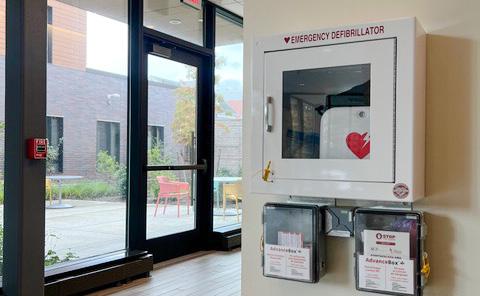
Above all, heartBEAT looks to expand access to the knowledge and the power to save lives, according to Jewett.
“It is incredibly rewarding to know that you are teaching community members to become confident and competent (that) they can save someone in an emergency medical situation,” wrote CRP instructor Rachel Huynh ’23 in an email to The Herald.
bring additional life to the neighborhood and support city and state goals,” he wrote.
Design and Construction, which has constructed a number of University buildings including the soon-toopen Lindemann Performing Arts Center.
The project’s first phase would be the residential building — an 11-story building across Parcel 14 and a portion of the University’s property. The first floor would include retail space, and the remaining 10 floors would encompass 149 units, along with a rooftop amenity deck and green roof. Of the 149 units, CV Properties committed to 10% workforce housing — affordable units for middle-income workers.
“This would be a private residential/commercial development led by CV Properties, not student housing,” wrote University Spokesperson Brian Clark in an email to The Herald.
The long-term master plan includes two additional buildings on land that would encompass Parcel 15 and the rest of the University’s Dyer Street property for a total of 512,000 square feet: 159,000 square feet of residential space, 120,000 square feet of office space and
233,000 square feet of lab space. The design conforms to city zoning and the I-195 Commission’s resiliency goals, and all properties will be added to the commercial tax roll despite the inclusion of property owned by the University, according to the release.
Beyond project approval, CV Properties is seeking a tax stabilization agreement under the TSA city ordinance for the I-195 District.
“This phased project offers immediate housing benefits and long-term
potential to significantly advance the economic development, land use and job creation goals of both the 195 Commission and the City of Providence,” said Founder and President of CV Properties Richard Galvin in the release. “Together with Brown University, we are able to create a more holistic parcel that has flexibility to support this mix of uses. I am grateful to Brown for their partnership and their vision for an improved public experience in the 195 District and nearby neighborhoods.”
CALENDAR
“Brown has long intended to redevelop the property at 200 Dyer St. as part of the Jewelry District’s continued transformation,” wrote Clark. Currently, 198-200 Dyer Street houses administrative offices and a parking lot, including the Office of College Admission at 198 Dyer Street.
The plan will not create any University spaces, Clark wrote.
“Our participation is not focused on creating Brown space, but rather helping to propel a broader project that would
TODAY’S
“Our goal is to help enable a project that would make use of a currently underutilized site in a way that supports city and state goals for the former 195 land, provide important tax revenue to Providence and continue the positive transformation of the neighborhood to one that is thriving, both culturally and economically.”
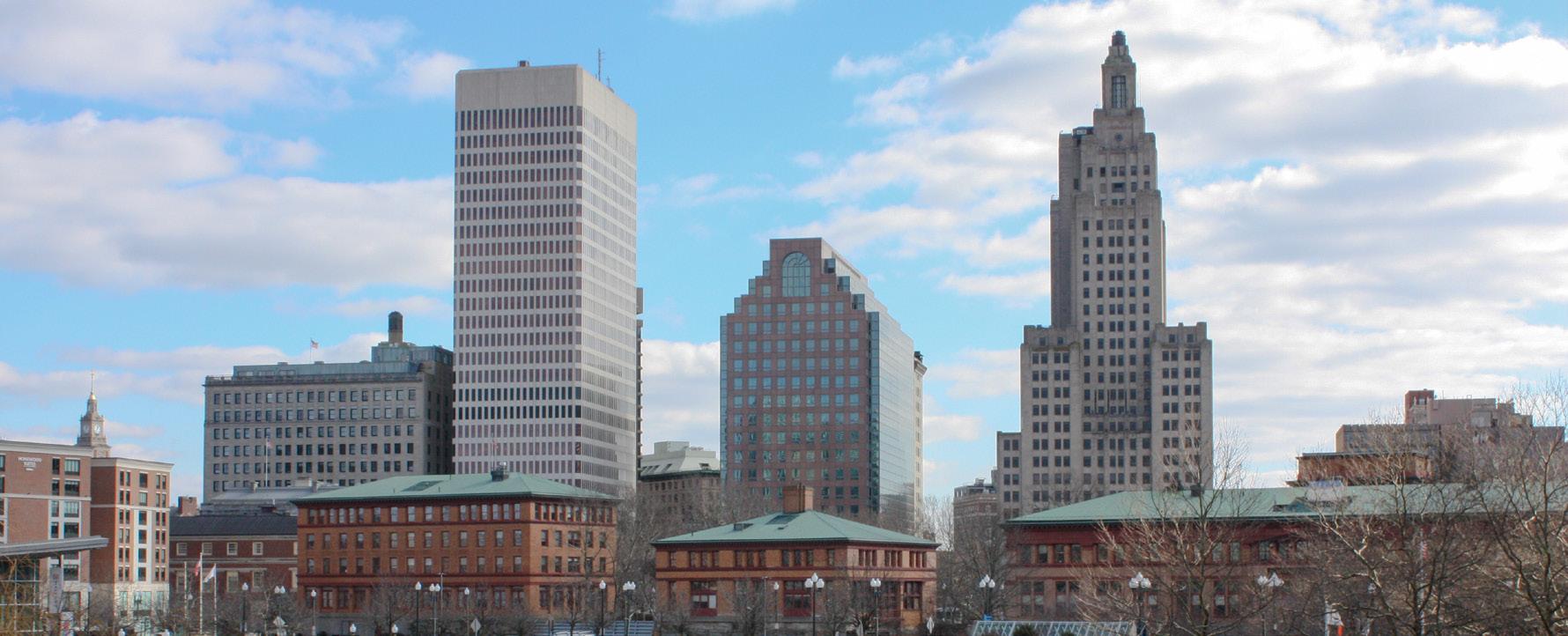
The project would combine properties under different ownership, but since it is currently in the form of a proposal, “the specific approach to ownership has not been determined,” Clark wrote.
“A distinct real estate LLC would likely be established as the owner of the entire site,” through which the University would “provide its 198-200 Dyer St. property to the project.”
“Specific details of all transactions would be determined with CV Properties if the proposal is approved,” Clark wrote. The proposed project will be presented by representatives from CV Properties at the Commission’s April 19 meeting, according to the release.
Faculty, admin discuss upcoming affirmative action SCOTUS decision
Roundtable at Sheridan Center discusses legacy admissions, legal history of affirmative action
BY RYAN DOHERTY SENIOR STAFF WRITER“Diversity experiences and engaged classroom experiences are the two most influential experiences (for) college students,” said Mary Wright, executive director of the Sheridan Center for Teaching and Learning and associate provost for teaching and learning. But two upcoming Supreme Court decisions — Students for Fair Admissions v. Harvard and Students for Fair Admissions v. University of North Carolina — may impact how the University promotes these experiences, Wright said at Thursday’s Sheridan Center roundtable event titled “Teaching and the U.S. Supreme Court Decision on Affirmative Action.”
To open the discussion, Eileen Goldgeier ’85, vice president and general counsel at the University, presented an overview of the history of affirmative action. She began by highlighting Regents of the University of California v. Bakke, the landmark 1978 Court decision which she said established the legal precedent that “diversity in student body admissions is a compelling state interest.”
Additional cases, such as Grutter v. Bollinger and Gratz v. Bollinger, affirmed the importance of diversity on college campuses, Goldgeier said. “The only reason that we can consider race and national origin as one of the factors (in admissions) is the educational benefits that it brings to students in the university,” Goldgeier said.
In the face of the upcoming rulings, Logan Powell, associate provost for enrollment and dean of admission, reaffirmed the University’s commitment to diversity. Powell shared demographic data highlighting the increased number of students of color enrolled in the University in recent years,
with 51% of students in the class of 2026 identifying as non-white.
“This growth has been consistent and it has been intentional,” he explained.
In the open discussion portion of the event, Powell touched on the topic of alternatives to race-conscious admissions, such as the consideration of zip codes, first-generation status and income status. “Every potential logical solution can get you somewhere but it doesn’t get you as far as you might hope,” he said.
Powell spotlighted research that Harvard “presented at the district court level … that there are no race-neutral alternatives.” In the district case, Harvard contended that it would not be able to achieve “its educational objectives (of having a diverse student body) without considering race” even with an increased focus on socioeconomic status and the elimination of certain criteria such as test scores and legacy admissions.
Powell then moved to discussing data gathered from the University of California
system. After the state passed Proposition 209 — a ballot initiative preventing the consideration of race in admissions processes — in 1996, schools saw a decline in the number of Black and Latinx applicants. “These two student groups no longer thought that they would be competitive for admission, even when statistically they would be,” he explained.
Andre Willis, professor of religious studies, and Emily Kalejs Qazilbash, professor of practice in education, both discussed how their roles as professors would be impacted if the Court were to strike down affirmative action.
“Diversity is the fundamental principle (that) organizes our capacity to think broadly,” Willis said.
“Our students benefit from being able to … learn from each other and … go out into the world having an understanding of different perspectives,” Qazlibash added.
Powell assured that the University will maintain its mission of understand-
ing applicants “individually, holistically and contextually” in its admission processes.“That third part is the part that will really require additional emphasis on our part as we go forward,” he said.
The panel also discussed legacy admissions and athletic recruitment in relation to affirmative action. In a February panel sponsored by the University’s education department, Powell expressed that the admissions office might use legacy status as one way to continue admitting a diverse class.
“A third of our legacy students are students of color,” he added. “We admit every year twice as many first-generation students as we do legacy students.”
Powell also said that the University has “athletic teams (that) are themselves very diverse.
The University is “thinking about (every) possibly legally compliant intervention” while waiting for the Supreme Court to rule, which is expected in late June, he added.
histories, according to Agarwal. She cited dowry rugs made in Punjab, which have next to no print or digital documentation of their making, as an example of what the section aims to present.
“Spaces and places” focuses on cross-cultural influences in South Asian architecture, while the “transcontinental conversations” section speaks to South Asia’s own relevance beyond the subcontinent. “literary musings” are “things that inspire us,” Agarwal said.
Agarwal highlighted that one of the main challenges while creating desi-gned with a small group — comprised of Agarwal, Thuppil, a design director and two editors — was capturing the plurality of South Asian culture, especially because the team was made up entirely of Indians. “How do we disassociate ourselves from being Indian and try to be South Asian?” she asked.
While working on the magazine, the team also employed the expertise of Brown and RISD professors.
Kate Irvin ’93, curator and head of the Costume and Textiles department at the RISD Museum, first met Agarwal in 2020 when the pair began to conduct research on Indian textiles. The research led Agarwal to receive a grant that sponsored her investigation of weaving techniques in Kashmir, which ultimately culminated in an article in the magazine.
For Irvin, the magazine expands the concept of scholarship. “It doesn’t always have to be the academic standard of an essay,” she said. “It can be poetry or … beautiful descriptive texts about objects that are personally meaningful.”
Bringing the magazine to life was a “labor of love,” Irvin said — but it also required raising a significant amount of money.
“I sent out close to 250 emails to people to be like, ‘Hey, please, can we have some money for this?’” Agarwal joked. “We’ve gotten close to 70% of our funding from Brown, even though this is a publication that has largely been born at RISD.”
Funding for the magazine came from RISD’s Fleet Library, Brown’s Ruth J. Simmons Center for the Study of Slavery and Justice, the Brown Arts
Initiative and Brown’s Saxena Center for Contemporary South Asia, as well as a number of others organizations, according to the publication.





The physical magazine — 150 pages and printed in color — is free for all who wish to read it. A digital version is also available.
“We don’t want to gatekeep information,” Agarwal said. “If someone wants to download it and drag a photograph out … to copy text and use it, that’s something you should be able to do.”
“Beautiful things should not cost money,” she said. “Knowledge should not cost money.”
‘This project has a heritage’: Designing and printing Mehek Vohra ’24 had never worked on a project of this scale when she was invited to design the magazine.
“I had never been educated about my own culture and art from my home,” she said. “This was a really good way not only for me to learn … but also to be more connected with my space.”
For Vohra, one of the biggest challenges was creating a cohesive aesthetic while respecting the visual individuality of each article.
To ensure cohesion, Vohra and Agarwal focused on creating visual motifs scattered throughout the magazine. One such pattern came from “jali,” which refers to “Arabic-inspired
stone curtains,” Vohra explained.
It was also important for Agarwal to publish the magazine in print as a way of creating “physical archives of knowledge.”
To print the magazine, the desi-gned team enlisted the help of Doug Scott, a graphic design professor at RISD.
“I am a great believer in printed things because that means this project has a heritage that will last, if not forever, for a long time,” Scott said.
‘Such a beautiful journey’: Celebrating the release
At the launch event in the Grand Gallery at the RISD Museum — a European art gallery — Agarwal said that the team worked to “think about how we can recreate” narratives traditionally centered around European art.
New labels were added to the gallery to “speak about the relationships that these paintings had with South Asia,” Agarwal said. The labels focused on hidden stories of the paintings, like how blue pigment used during the Renaissance came from lapis lazuli stones in Afghanistan.
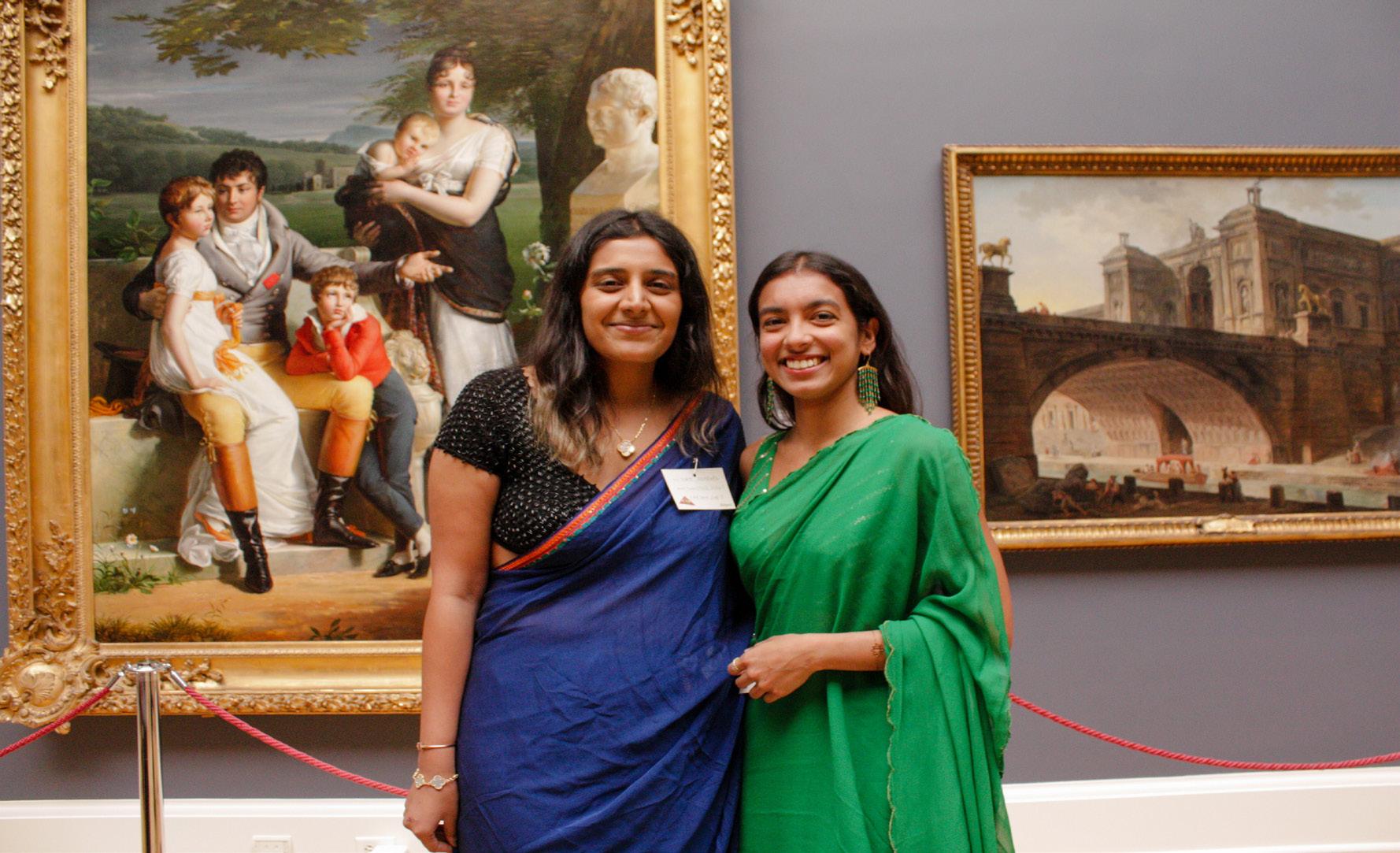
For Tanvi Anand ’26, desi-gned stands out for its focus on highlighting art and design from South Asia, which is “not really recognized,” she said.
Holding hands, Vohra and Agarwal thanked each other and the people who helped bring the project to life.
“I want to thank Yukti,” started Vohra, only to be interrupted by Agarwal. “I want to thank you!”
“It has been such a beautiful journey. I’m really proud of it,” Vohra said to applause.
In the future, Agarwal imagines desi-gned as an annual publication that will accept submissions from all people who “had experiences with South Asia.”
RISD Dean of Libraries Margot McIlwain Nishimura, who has provided support to Agarwal, noted student-led projects often face the challenge of continuing their work and cultivating future leaders.
“I hope that it can be established as an ongoing publication, because … there isn’t any other publication … that really speaks to (the South Asian) community and elevates (its) arts and culture” in this way, Nishimura said.
According to Agarwal, the team has been working to create “a repository” for any student group that would like to share knowledge of “their cultures, their people (and) their perspectives” — with design templates and guides to tackling logistical challenges.
Many people have already expressed interest in joining the publication, Agarwal said. “I’m really excited for someone else to … have experiences like this because it’s made me feel more ready for the world than any internship, any kind of job or class.”
Sandoval ’23, Spencer-Blume ’23, Sarmas ’24: Rhode Island needs to increase its financial aid for in-state students
Rhode Island must restore funding to the Rhode Island Promise 1.0 scholarship program for students at nonprofit institutions to its pre-pandemic level of $2 million. In March, Brown University’s Student Government Association — composed of the Class Coordinating Board, the Undergraduate Council of Students and the Undergraduate Finance Board — passed a joint resolution calling on the Rhode Island General Assembly to increase funding for the program by $500,000 in the next fiscal year.
The Rhode Island Promise redesigned the state’s existing financial aid program as a last-dollar scholarship in 2015 with the goal of making attending college more affordable for Rhode Islanders. Funds from this program can be used by any student from Rhode Island at any institution within the state, public or private. Since the program’s inception, nonprofit institutions like Brown have pledged a dollar-for-dollar match of all funds received through the program. Since 2015, the program has generated $29 million in student aid. Historically, $2 million of the total funding for the program were set aside specifically for students attending private institutions. The state cut this amount to $1.5 million beginning in the 2021 fiscal year and the number has remained at that level ever since, to the great detriment of both students and the state.
According to a report from the Association of Independent Colleges and Universities of Rhode Island, we are far behind neighboring states when it comes to our state student aid
program. In Massachusetts and Connecticut, students at private institutions receive $36 million and $5.7 million in state aid respectively, while Rhode Island trails behind with only $1.5 million. Only 9% percent of Rhode Island’s student aid budget goes to students at private institutions, compared to 28% in Massachusetts and 17% in Connecticut. Rhode Island must do more to support in-state college
from Rhode Island’s private higher education institutions while displacing community members — siphoning resources that would otherwise be available to Rhode Island residents.
We believe that the factor of belonging is crucial to the success of all groups. When Rhode Islanders are well-represented at AICU Rhode Island institutions, they experience a supportive community that they can then
ing state student aid will increase the number of Rhode Islanders who can afford to acquire postsecondary credentials at colleges like Brown. If Rhode Island private colleges cannot offer reasonable financial aid packages, students may well attend out-of-state colleges, making it less likely that they would return to and work in Rhode Island. This would make Rhode Island vulnerable to losing a highly qualified former resident.
With the House Finance Committee still considering the budget containing the Rhode Island Promise, it is time to urge Rhode Island legislators to advocate for students from Rhode Island and increase funding for last-dollar scholarships at private colleges. If the budget is amended, and nonprofit institutions continue to match the state’s level of funding, an additional $4 million in aid would effectively be available to students from Rhode Island attending private institutions such as Brown.
students.
Why is this important? First of all, 85% of students attending member institutions of AICU of Rhode Island come from out-of-state. According to the University’s enrollment factbook, just 6% of students at Brown are permanent residents of Rhode Island — and just 15% of students attending AICU Rhode Island institutions are Rhode Islanders. This gap must be bridged. Out-of-state students are benefitting
extend to out-of-state students. They create community within and between our school, Providence and Rhode Island. They remind our international and far-from-home cohort here at Brown of the crucial importance of global and local approaches to education and of the immediate stakes of engaged scholarship.
Obtaining a college degree is often the single most important step an individual can take to increase their social mobility. Increas-
Carina Sandoval ’23 can be reached at carina_sandoval@brown.edu. She is CCB senior co-president. Amienne Spencer-Blume ’23 can be reached at amienne_ spencer-blume@brown.edu. She is chair of UFB. Mina Sarmas ’24 can be reached at mina_sarmas@brown.edu. She is the vice president of UCS and incoming UCS president. Please send responses to this opinion to letters@browndailyherald.com and other op-eds to opinions@browndailyherald.com.
SINCE 1891
THE BROWN DAILY HERALD
133rd Editorial Board
Editor-in-Chief
Will Kubzansky
Managing Editors Katy Pickens
Alex Nadirashvili
Senior Editors Augustus Bayard
Caleb Lazar
Peter Swope
Kaitlyn Torres
Post- Magazine
Editor-in-Chief
Kimberly Liu
News Metro Editors Emma Gardner
Rhea Rasquinha
Jacob Smollen
Julia Vaz
Science & Research Editor

Haley Sandlow
Senior Science & Research Editor
Gabriella Vulakh
Arts & Culture Editors
Aalia Jagwani
Finn Kirkpatrick
Rya Vallabhaneni
Sports Editor
Linus Lawrence
University News Editors
Sofia Barnett
Charlie Clynes
Emily Faulhaber
Grace Holleb
Sam Levine
Neil Mehta
Haley Sandlow
Kathy Wang
Digital News Director of Technology
Swetabh Changkakoti
Opinions
Head Opinions Editor
Alissa Simon
Opinions Editors

Anika Bahl
Bliss Han
Melissa Liu
Jackson McGough
Multimedia
Illustration Chief
Ashley Choi
Photo Chiefs Elsa Choi-Hausman
Dana Richie
Photo Editors
Mathieu Greco
Claire Diepenbrock
Lilly Nguyen
Kaiolena Tacazon
Social Media Chief
Sahil Balani
Social Media Editors
Emily Faulhaber
Coco Huang
Alyssa Sherry
Kaiolena Tacazon
Production
Copy Desk Chief
Brendan McMahon
Design Chief
Neil Mehta
Design Editors
Sirine Benali
Maddy Cherr
Ashley Guo
Gray Martens
Business General Managers
Joe Belfield
Andrew Willwerth
Sales Director
Alexander Zhou
Finance Director
Submissions: The Brown Daily Herald publishes submissions in the form of op-eds and letters to the Op-eds are typically between 600 and 900 words and advance a clear argument related to a topic of campus discourse. You can submit op-eds to opinions@browndailyherald.com.
Letters to the editor should be around 250 words and respond to an article or column that has appeared in The Herald, or critique or commend The Herald’s editorial decisions. You can submit letters to the editor to letters@browndailyherald.com.
Submissions undergo multiple rounds of editing. These rounds of editing generally take place over the course of one evening, and you may have to respond to edits late in the evening. If you know you will be unable to do so, please mention that in your email, and we will do our best to work with you.
Submissions can build on reporting from The Herald, reporting elsewhere, official statements from the University or other groups and other reputable sources, but they cannot break news or contain information that The Herald cannot verify. Because we cannot publish unsubstantiated information, failure to provide appropriate sources may mean we have to modify or remove unverified claims.
The Herald will not publish anonymous submissions or submissions authored by organizations. Leaders of student organizations can be identified as such but cannot write under the byline of their organization.
The Herald cannot publish all submissions it receives and reserves the right to edit all submissions. All submissions to The Herald cannot have been previously published elsewhere (in print or online — including personal blogs and social media) and must be exclusive to The Herald. Once your submission is published in The Herald, The Brown Daily Herald, Inc. owns the copyright to the materials.
Commentary: The editorial is the majority opinion of the editorial page board of The Brown Daily Herald. The editorial viewpoint does not necessarily reflect the views of The Brown Daily Herald, Inc. Columns, letters and comics reflect the opinions of their authors only.
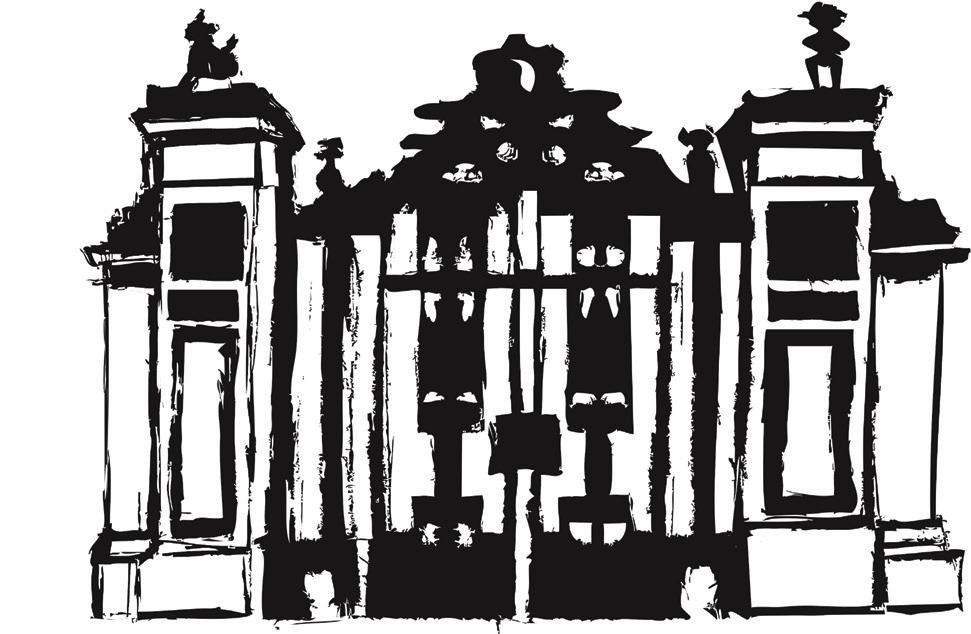
Corrections: The Brown Daily Herald is committed to providing the Brown University community with the most accurate information possible. Corrections may be submitted up to seven calendar days after publication. Periodicals postage paid at Providence, R.I. Postmaster: Please send corrections to P.O. Box 2538, Providence, RI 02906.
Eli Pullaro
Editorial Page Editor
Kate Waisel
Julian Beaudry
Nadia Bitar
@the_herald facebook.com/browndailyherald
@browndailyherald @browndailyherald
Advertising: The Brown Daily Herald, Inc. reserves the right to accept or decline any advertisement at its discretion. 88 Benevolent, Providence, RI (401) 351-3372 www.browndailyherald.com
The Brown Daily Herald, Inc. is a financially independent, nonprofit media organization bringing you The Brown Daily Herald and Post- Magazine. The Brown Daily Herald has served the Brown University community daily since 1891. It is published Monday through Friday during the academic year, excluding vacations, once during Commencement and once during Orientation by The Brown Daily Herald, Inc. Single copy free for each member of the community. Subscription prices: $200 one year daily, $100 one semester daily.
Editorial: herald@browndailyherald.com Advertising: advertising@browndailyherald.com
Copyright 2023 by The Brown Daily Herald, Inc. All rights reserved.
“When Rhode Islanders are wellrepresented at AICU Rhode Island institutions, they experience a supportive community that they can then extend to out-of-state students.”
Sender ’25: Providence can win the next decade — here’s how
After writing about and studying this city for two years, I feel absolutely confident that Providence has more potential to restore its former prosperity than any other city in the United States, but it must take the steps to realize it. There are a number of great economic and cultural shifts underway across the country, and if Providence positions itself correctly, it can grow into the city it deserves to be — and Brown must help it do so.
The movement away from in-person work for many white-collar professions is reorienting the economic foundation of American cities. Since the deindustrialization of the American city in the aftermath of World War II, tax bases for many cities have been supported by office space, a shift that aided cities with significant amounts of existing commercial space to grow. However, cities like Providence which never attracted the same volume of offices shrank considerably from the 1950s on. Today, though, the pandemic and the shift to remote work have led to a devaluation of office space, a shift which has leveled the playing field. Now, the most valuable thing a city can offer potential transplants is no longer its office space, but its livability and community.
In this light, Providence is a highly desirable city to outsiders. Its network of dense, walkable neighborhoods with unique cultural offerings is a treasure highly valued by a generation of workers no longer tied to their offices. That said, the city is not quite ready for prime time: It is livable, with strong communities, but it lacks some key features that would truly elevate it and draw in the next generation of workers. For example, the city sorely needs improved public transportation, bike safety and pedestrian safety. Between 2012 and 2021, 2,200 pedestrians and 904 bikers were struck by cars in Providence. Most streets still lack the pedestrian and bike-friendly infrastructure needed to make the city more desirable for relocating young workers. This, coupled with the fact that the Rhode
Island Public Transit Authority is facing a high likelihood of becoming severely underfunded, makes transportation in the city both inaccessible and undesirable. Still, there are opportunities for growth in Providence’s livability: The city just received a $27 million grant that could fund bike infrastructure, an investment that has the potential to enhance the bike network
areas with unreasonably stringent density requirements. Perhaps, the city could even remove parking minimums on larger developments in exchange for developers’ investment in public transportation. All of these measures would help Providence affordably accommodate new workers without displacing existing residents.
Providence must also capitalize on what it
help its home realize its full potential. If Brown wishes to flourish, it must invest in its relationship with its neighbors.
The University should dispense with the idea that it can exist in a vacuum from Providence. Brown is a part of the larger tapestry of the city, and the fences surrounding it only serve to unravel the ties holding the community together. With this in mind, Brown should welcome the community into its halls. Public school students should have complete access to library resources — not just online databases, but all of the physical study spaces themselves. Providence residents should have access to the campus athletic and recreational facilities. All of Brown’s future developments should consider the needs of the community and the neighborhood’s architectural vernacular.
greatly.
This alone is not enough, though. Rhode Island is facing a severe housing crisis: Attracting new residents without housing to accommodate them could lead to disastrous displacement. Providence must build much more housing — both affordable units and more expensive market-rate housing — and it can facilitate this through a number of different policies. It should aim to reduce the amount of red tape standing in the way of approving housing. The vast number of clauses attached to public construction like housing, while well-intentioned, increases the complexity of jobs, and thus their cost, considerably. Providence should also look to successful creative cooperative housing solutions, which increase the density of neighborhoods while preserving their character and affordability. Further, Providence should restructure its zoning requirements to allow for greater private construction of more housing on vacant lots and
To the Editor
already has. The city has one of the most vibrant restaurant scenes in the country, and it should do everything in its power to enhance the diversity and volume of wonderful food offerings. It also has a growing biomedical sector, and further development in this field could position Providence towards the front of an industry that is expected to grow. Additionally, Rhode Island has announced an ambitious plan to provide the majority of the state’s electricity from offshore wind — making it a potential hub for clean energy on the East Coast.
Perhaps Providence’s greatest asset, though, is its wealth of universities and professional institutions. In this regard, however, Providence has largely been disempowered from reaping the benefits, and it is incumbent upon the universities themselves to support the city they call home. Specifically, Brown, as one of the largest and most influential entities in the city, must forge a new path forward with Providence to
Most importantly, Brown must pay its fair share to the city which has enriched it so greatly. Making payments in lieu of taxes should not be a great struggle — in fact, Brown should be proactive in assisting the city, perhaps even becoming a partner in the development of affordable housing and public transit. While this may seem radical, Brown flourishes most when the city around it thrives: Providence is as much a selling point for Brown as Brown is a selling point for Providence.
The future of Providence is by no means certain, but for the first time in decades, it seems not just poised for growth, but a true resurgence. The city must be proactive and take the reins of its future with bold leadership. This alone will not be enough, though — Brown too must forge a new path, as Providence’s foremost institution, and walk hand-in-hand with the city into a brighter future.
Gabriel Sender ’25 can be reached at gabriel_sender@brown.edu. Please send responses to this opinion to letters@browndailyherald.com and other op-eds to opinions@browndailyherald.com.
Thank you for the recent article penned by Bishakha Oli ’24, “‘End of an era’: Exploring the legacy of Pembroke College.” What a nostalgic walk down memory lane for all of us who matriculated through Pembroke College — and a reminder of how things have changed!
My Pembroke class of 1968 was right in the middle of the changes that those from the classes of 1966 and 1970 described. We suffered through the same parietal rules and arcane dress codes and challenged our unequal treatment as well. In our sophomore, junior and
senior years, many of us protested when we felt we needed to call attention to inequities, but we also worked to lobby for specific remedies to both campus and national policies. We are continuing this tradition of working for a better world today.
Long before the COVID-19 pandemic and the rise of the internet, members of the class of 1968 were meeting in person in New York and elsewhere — celebrating milestones at gatherings that brought together classmates from around the country and globe. The advent of email
strengthened and broadened our communication. Now, about 65 of us share messages daily about national and global happenings; research on historical, cultural and other compelling issues; personal news; and more. When COVID-19 hit, we pivoted to weekly Zooms that are still going strong and attracting a broad audience. The memory of Pembroke lives on in these spaces.
Today our small group has memorialized our time through the Pembroke Emergency Gap Fund endowment —you can search for the fund at https://bbis.advancement.
brown.edu. This will provide a financial boost to current and future generations of women undergraduates so that they can better meet unexpected financial challenges while at Brown. Brown will disperse the first awards from the fund next academic year, but its current resources are limited and it needs all of our continued support — from alums and friends of Brown alike — to ensure that it will be self-sustaining in the future, long after many of us are gone.
Sally Kusnitz Horn ’68, P’97, MD’01
In this week’s episode of The Bruno Brief, the team explores Brown’s reputation as the “Happy Ivy” and how this status affects student experiences and perceptions of mental health on campus. Why does Brown have this reputation? And is it really true?
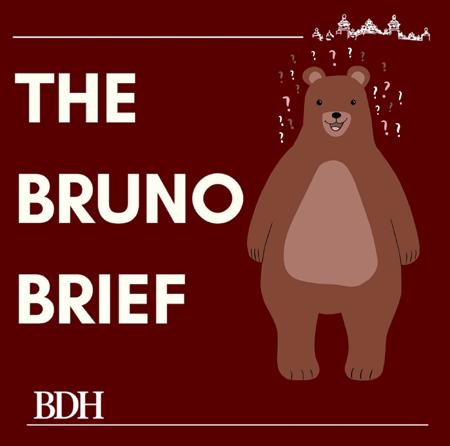
Subscribe to the podcast on Spotify or Apple Podcasts or listen via the RSS feed. Send tips and feedback for the next episode at herald@browndailyherald.com.
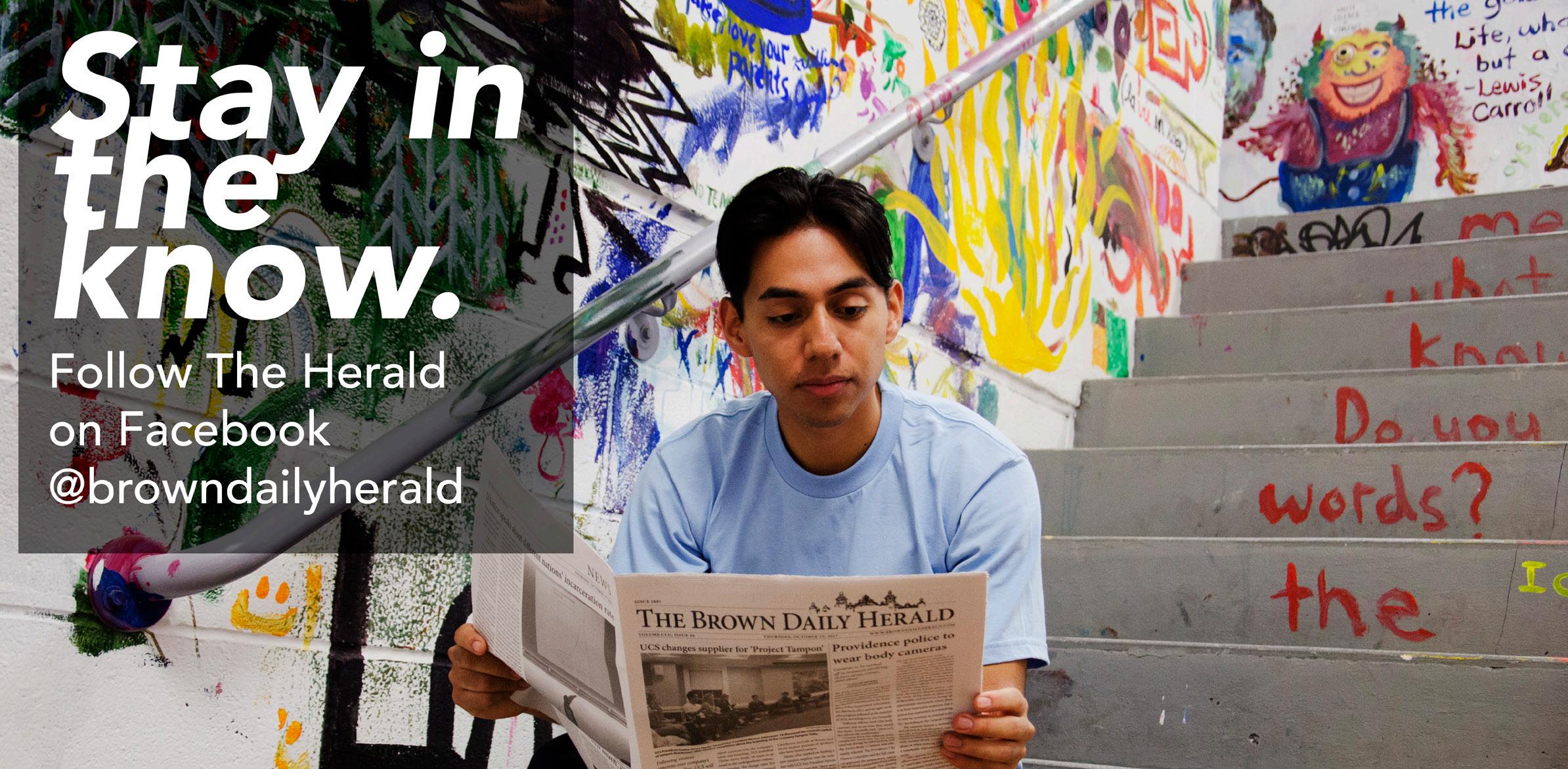
The Bruno Brief is produced in partnership with WBRU.
Hear the full report on this week’s Bruno Brief.
“If Providence positions itself correctly, it can grow into the city it deserves to be — and Brown must help it do so.”
ARTS & CULTURE
Netflix’s ‘Murder Mystery 2’ delivers perfectly superficial plot, comedy
Jennifer Aniston, Adam Sandler return for fast-paced twists, high production value
BY SAHIL BALANI STAFF WRITEROn March 31, Netflix released “Murder Mystery 2,” a sequel to its popular 2019 comedy. The much-awaited Jennifer Aniston and Adam Sandler flick skyrocketed to the top of Netflix’s Global English films in the first week of April, also pulling its prequel from Netflix’s graveyard to the second spot in the same category.
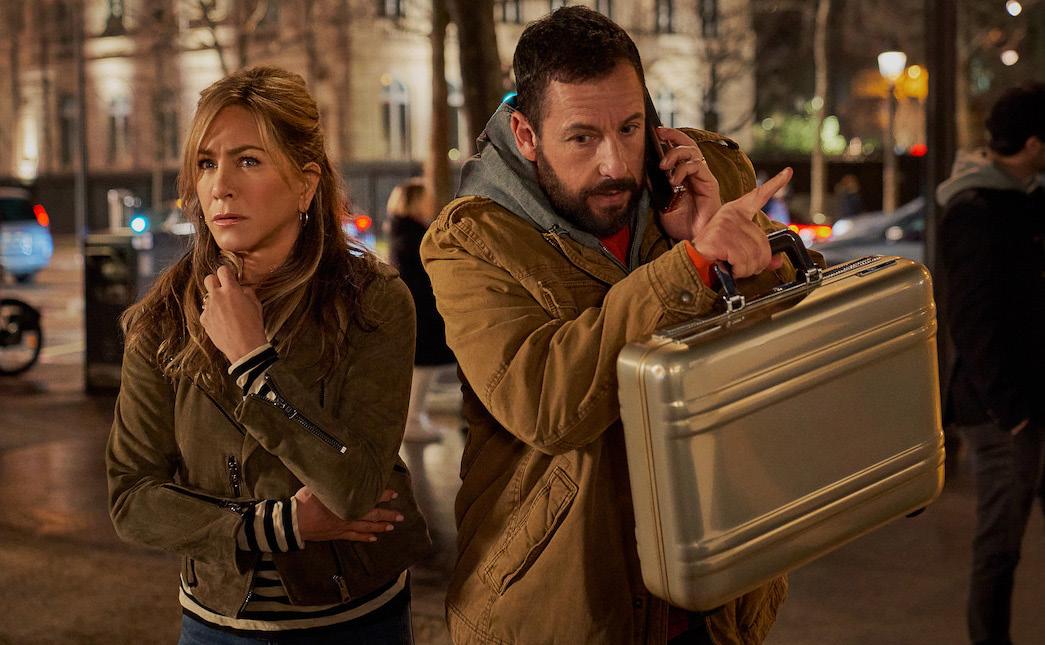
The film is set four years after the first movie. Audrey (Aniston) and Nick Spitz (Sandler), who now operate a private detective agency, find themselves investigating the abduction of their billionaire friend, the Maharajah (Adeel Akhtar), who is set to marry the French model Claudette Joubert (Mélanie Laurent).
The film’s mystery plot feels secondary to Aniston and Sandler’s spotlight-stealing comedic banter and on-screen chemistry. Audrey
without a certified teacher in front of them.”
Calabro emphasized the effect of low teacher retention on educators, writing that teachers who have to cover these vacancies during planning periods must plan their instruction at home instead.
Additionally, “at the elementary level, the classrooms are ‘split’” due to the shortages, “with small groups of children being placed in other classrooms for the day, which can also disrupt the flow and consistency of the receiving classroom,” Calabro wrote. Some students who are moved may even be from a different grade, she added.
Calabro recognized that a concerted effort has occurred over the last two years to attract teachers to PPSD. But this effort must be coupled with incentivizing teachers with “knowledge, experience and a wealth of professional development” to stay in Providence, she added.
“Based on the reasons we have been given by teachers who have left for other districts, low morale, disrespect, the takeover and having to get a (multilingual learners) certification to keep positions are all factors that have contributed,” Calabro wrote.
Responding to claims that dif-
SIBLINGS FROM PAGE 1
Lily Ward-Diorio was named valedictorian of her high school, with Rebecca Ward-Diorio as salutatorian.
Powell emphasized that the applications of siblings are reviewed individually. “A student is going to move forward in the process or not based on the strength of their academic background, their extracurricular involvement and their ability to make positive contributions to the Brown community,” he said.
He also noted that “it’s quite different when siblings apply in different years because the applicant pool can change pretty dramatically.”
When decision day arrived, the
and Nick are like perfect puzzle pieces made to fit with each other. The mixture of Audrey’s responsible and organized attitude with Nick’s clumsy and cheese-obsessed demeanor will undoubtedly make audiences crack up. And while some action sequences in the film might seem cringy in theory, Aniston and Sandler’s strong comedic timing helps viewers forget the absurdity of the situations.
But the focus on Aniston and Sandler’s relationship doesn’t entirely make up for the film’s surface-level
plot. To keep audiences engaged, the film resorts to constant plot twists, from intense character reveals to out-of-pocket car explosions. But screenwriter James Vanderbilt can take pleasure in the fact that he certainly created an enjoyable movie.
Because of the film’s fast-paced plot twists, many interesting characters receive little screen time and lack character development. Countess Sekou (Jodie Turner-Smith) was reminiscent of a meaner Blair Waldorf and added a unique dynamic to the mix.
Inspector de la Croix (Dany Boon) felt like an archetype of the “Knives Out” franchise. Audiences are likely to want more from both of these characters going forward.
The film also portrays an accurate and fun Indian wedding — though the elephant inside the small wedding tent was a little uncalled for.
The wedding provided costume designer Debra McGuire with an amazing opportunity to highlight Indian designers. The ivory lehenga by Manish Malhotra for Aniston was a perfect choice. In an interview with Vogue India, McGuire said, “I gravitated towards the more traditional, which I felt would be more respectful and fitting to how the scenes were written.” Whether the costumes at the wedding were by Malhotra or Papa Don’t Preach, they showed an understanding of what modern India would wear to a wedding.
And no Indian wedding is complete without Bollywood music. The duo Avinash-Vishwajeet composed “King Dee Wedding” for the film, which was perfectly on trend with current songs in the industry. The film also features songs like “Et moi, et moi, et moi” by
Jacques Dutronc and “Bang Bang” by Sheila that perfectly match each scene they are a part of.
The film’s off-camera artists also deserve acknowledgment. Cinematographer Bojan Bazelli perfectly captured the streets of Paris and Production Designer Perry Andelin Blake made most of the film’s frames, including one which featured a replica of the Eiffel Tower, extremely believable.
Set decorators Niamh Coulter and Jeanette Scott added an eclectic and carefully-selected collection of props to the sets, making them feel more life-like. “The villa (in the film) was built in a convention center,” Scott explained in a message to The Herald. “It was meant to be very luxurious.”
“Murder Mystery 2” is far from a perfect film, but perfection was never its goal. The movie’s comedy and surprise elements account for a film that is ideal to watch on a Friday night to unwind after a stressful week. Now audiences must simply wait to see if Netflix decides to add a third installment to the franchise, though it would certainly be fun to see Aniston and Sandler share screen space one last time.
ficulties stemming from the RIDE takeover are fueling high turnover, Victor Morente, communications director at RIDE, wrote in an email to The Herald that there is a teacher workforce challenge nationwide. Morente cited a 2022 report from the American Federation of Teachers that noted struggles with teacher retention before the pandemic.
“The pandemic only made things worse,” the report read.
On May 7 and 8, RIDE will hold a statewide educator job fair, Morente added. “At this point, over 25 districts have signed up to participate because they too are facing workforce challenges like Providence.”
The Annenberg report also found
Ward-Diorio twins opened their decisions separately, while the Mukai twins opened theirs together.
“I came downstairs, and our mom freaked out,” Lily Ward-Diorio said. “We just celebrated for the rest of the night.”
Immediately, the Ward-Diorio twins knew that they would both attend Brown. They said to each other, “Well, if there are any challenges in going to the same school, we’ll just figure it out,” Lily Ward-Diorio added.
But the Mukai twins continued to entertain other options. “There was definitely a time in the process where we were really considering splitting apart,” Kayla Mukai said. Both twins were leaning toward other schools until
that PPSD has not made the gains it hoped to in diversifying its teacher workforce: Currently, the district is diversifying at a rate of “less than 0.5 percentage points a year” — 21.8% of the district’s educators are teachers of color.
“There is such a gap between what the student body looks like and what the teacher workforce looks like,” Donohue said. According to statistics from PPSD, over 90% of the district’s students are students of color.
She also noted that it is difficult to increase teacher diversity, although PPSD has made some improvements. Pre-pandemic, around 15% of new teacher hires were people of color, according to Donohue. Now, that
they appealed their Brown financial aid packages to match the institutional aid they were offered by other schools.
As a need-blind school, Powell said that sibling enrollment in any college — which could increase the amount of aid awarded in some cases — “has no impact on our decision-making process.”
Since arriving at Brown, all four students have each carved out a place on campus apart from their siblings. Rebecca Ward-Diorio is studying marine biology, while Lily Ward-Diorio is concentrating in International and Public Affairs.
“We have separate interests, so it wasn’t really a problem,” Rebecca
number is around 30%.
“40 to 50% of all new teachers have to be teachers of color” for PPSD to hit its targets of a two percentage point increase in educators of color annually, Donohue added. “Their applicant pool just doesn’t look like that.”
“To alleviate workforce challenges, PPSD has already begun its hiring process earlier than in years past, launched a robust recruitment campaign and is offering a wide array of incentives to attract and retain top talent with particular focus on highneed areas,” wrote Suzanne Ouellette, deputy director of external affairs at PPSD, in an email to The Herald.
According to Ouellette, PPSD
Ward-Diorio said — though after much wrangling, Rebecca convinced Lily to join her ultimate frisbee team.
Kelly Mukai spends much of her time studying engineering, while Kayla Mukai specializes in computer science. While they often hang out with the same group of friends, Kelly Mukai noted that “I hang out with my engineering friends.”
“And I hang out with my CS friends,” Kayla Mukai added.
During their time together in Delta Gamma, an on-campus sorority, Kelly and Kayla Mukai have collaborated heavily on event planning and live, by random selection, in the same room in Goddard House.
has implemented hiring and retention incentives for teachers and non-teaching staff alike by expanding its referral program to engage district staff in the recruitment process and establishing the Educators of Color Loan Forgiveness program, which helps teachers of color pay back student loans. “Through these efforts, PPSD has greatly increased the number of new hires compared to prior to the intervention, including more new educators of color,” Ouellette wrote.
“The more we dig into (staffing), the more questions we have,” Donohue said. “That really just speaks to how difficult and complex it is to staff a district with effective teachers.”

Reflecting on her and her sister’s undergraduate experience, Lily Ward-Diorio said that “Brown is big enough, and our interests are different enough, that it was a very individualistic experience.”
“I really can’t see us ending up in the same city after college,” Rebecca Ward-Diorio said. “Although that’s what we thought about college, so we’ll see.”
The Mukai siblings shared a different outlook. “At the end of the day, I was happy to have a built-in best friend coming onto campus,” Kelly Mukai said.
Kayla Mukai agreed: “I’m just really grateful that we both got in.”
